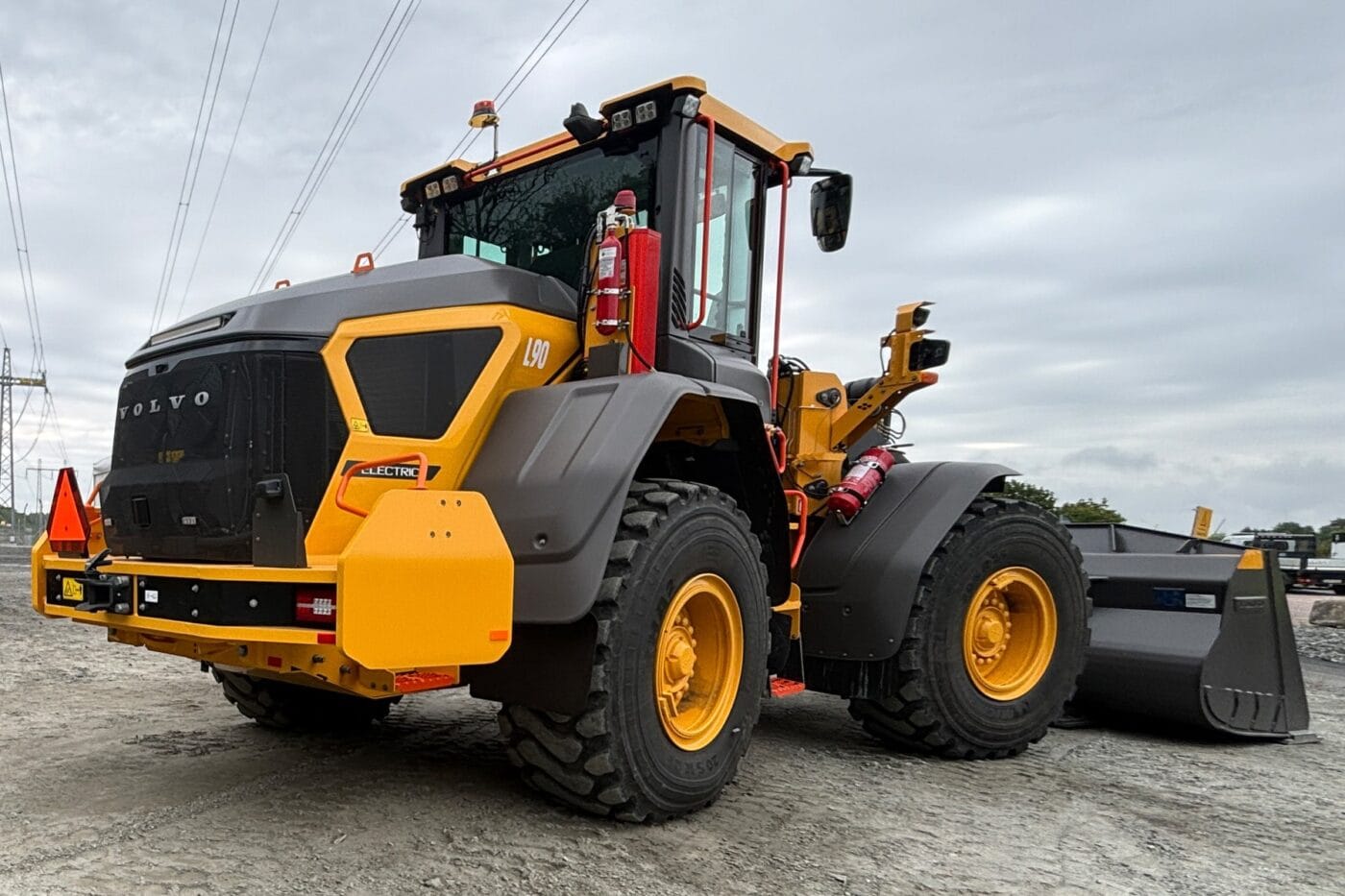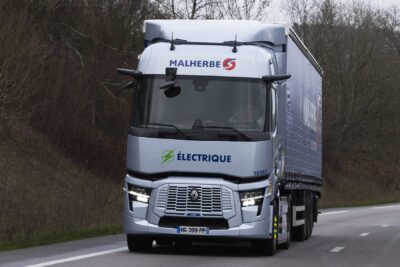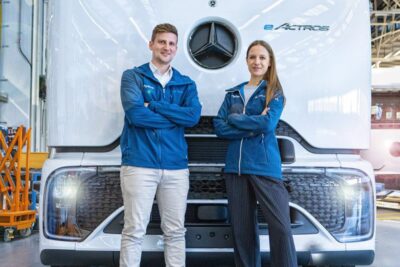
“The ramp-up is too slow” – Interview with Lars Stenqvist on truck electrification
“Everyone has to do their part to make the transformation a success.” With this passionate appeal in his keynote, Lars Stenqvist, Chief Technology Officer at the Volvo Group, kicked off EVS38 in Gothenburg last week. The Electric Vehicle Symposium is something of a travelling circus for the thought leaders and pioneers of electric mobility. The conference (and its accompanying exhibition) has been moving from continent to continent for decades. It’s a meeting ground mainly for engineers, scientists and technical experts – people like Lars Stenqvist.
The Volvo Group, headquartered in Gothenburg, made the most of its home advantage at EVS38 with a major push in e-mobility communications. And not without reason: with 5,000 electric trucks delivered, the globally operating commercial vehicle manufacturer is well ahead of the competition. Even heavy construction equipment such as excavators and dumpers from subsidiary Volvo Construction Equipment are already being delivered in significant volumes with battery-electric drivetrains.
Still, Lars Stenqvist remains unsatisfied. The transformation, in his view, is progressing too slowly. “The electric vehicles are here,” he said pointedly in his keynote. But stimulating demand, he continued, cannot be the manufacturer’s job alone. All players across the value chain must roll up their sleeves and establish successful business cases. Only then can e-mobility – whether on construction sites or on the roads – truly take off.
At electrive, we seized the moment in Gothenburg to take a few test drives with the Volvo Group’s various electric trucks. From refuse collectors to heavy-duty trucks, from compact to heavy excavators. Even an (impressive) test drive in a fully autonomous city bus was possible in the closed-off area of the Volvo Trucks Customer Experience Centre. And, of course, we also spoke with the impatient Lars Stenqvist:
Volvo Trucks holds a 60 per cent market share of the electric truck market in Europe. As CTO of the world’s leading transport solutions provider, what do you see as the most transformative technologies in shaping the future of heavy-duty transportation?
We need to decarbonise road transport and infrastructure. We are certain that it will not be sufficient to focus on one technology. There is no silver bullet to decarbonise our industry. Cars can almost become 100% battery-electric. In our industry, it will not work. So, we are working on battery electric and fuel cell electric vehicles that run on hydrogen. But we are also continuing to develop the combustion engine, which will then, of course, run on fossil-free renewable energy. So, we have the three technologies in parallel, and we are investing a lot in all three technologies.
But the focus is on the electric drive…
We started quite early with the battery electric side, and we are seen as pioneers, both in Europe and in North America. Volvo Group first offered electric city buses, but there was no real interest from the truck side. That came later. And we were able to take our components from the buses that were designed in a very modular way and rather easily install these parts into the trucks. That is the reason why we are seen as the pioneers when it comes to trucks in both Europe and North America.
Would it not be more efficient to pick one technology and invest in that instead of spending money on developing different drivetrains, and waiting to see which one will win the race?
We are convinced that we will see high volumes of all three technologies going forward. It will not be my engineers who will decide what will work for what application. It all depends on the availability of energy, the form of energy and the price of energy in different regions. For example, BEVs are perfect if you have a well-developed charging infrastructure. But in certain regions of the world, it will not be so easy. And if you cannot charge, then all of a sudden, that technology is sort of disqualified. So, we believe that we will see the same kind of transport application, but a customer in Region A will use battery-electric trucks, the one in Region B, hydrogen on fuel cells, and in Region C, combustion engines running on biogas, for example.










Volvo Trucks has delivered 5,000 electric trucks. But you say that uptake is not going quickly enough. In terms of legislation, what do you wish for to get the ball rolling a little faster?
I’m not looking for more legislation or for more regulation. I’m looking for incentives to stimulate demand. I am both optimistic and pessimistic because if I look at the registrations of trucks in Europe, e-trucks only accounted for 1.5% in the first quarter of this year. That is almost nothing. But when we look at the statistics country by country, we have reason to be optimistic. In Switzerland, the market share of electric vehicles is 11 per cent, in Norway, it is around nine per cent, and the Netherlands are not far behind either. So it is clearly happening.
What makes it successful?
These countries are successful because they have predictable long-term incentive schemes. The best example is Switzerland because they decided to have zero road tax for zero-emission vehicles. That means they are letting the polluting technology pay for the transformation. We like these usage-based incentives because when you buy an electric truck, you have an incentive to use it as much as possible to clock the kilometres.
What about technology – would you prefer Brussels to say which technologies they will support and which ones they will support to limit your investment in all these different approaches?
Never. I am very clear about that. I want our politicians and our legislators to tell us what they want to achieve. I have the best engineers in the world, and they will come up with the technical solutions. Take the discussion about banning combustion engines. That is an example of legislators and politicians making decisions without really understanding what the outcome will be. They should clearly define what they want. Is it the air quality they’re after? Or noise reduction? Or a combination of different factors? My engineers will work out the best technical solutions to achieve these goals. However, I am sceptical when a politician or a legislator starts to ban a certain technology because they do not understand the power and potential of technology going forward.
You mentioned your role as a pioneer in Europe and North America in the field of electrification of heavy-duty transport and other commercial vehicles. How do you plan on staying in the pole position?
We have 16,000 engineers and we invest three billion euros per year in research and development. That is necessary to drive the transformation. You must be in good financial shape so you can afford these investments. And I’m not sure that everyone will be able to finance this transformation. Maybe the competitive landscape will look different when we are through this transformation.
Volvo Trucks wants to be net-zero by 2040 and replace its rolling population of trucks with zero-emission vehicles by 2050. How do you manage this transition from the combustion engine to new drivetrain technologies in terms of personnel, especially with regard to the 16,000 engineers that you employ?
We are not stopping the development of combustion engines, for example. 2024 was a record year. We have never, ever invested so much money into combustion engine development as we did last year. So it’s definitely not going away. And we are recruiting a lot of new engineers coming in with a lot of new skills, directly from university or with experience in batteries, electrical motors, software, and so on. But many of our engineers with experience in the combustion engine are making the switch to electric mobility and acquiring new skills. I have so many examples of this. And I would argue that an engineer who is not curious is not an engineer.
Looking about five years down the road, what do you say are the biggest problems in technology in terms of electric vehicles and infrastructure that your engineers need to solve?
Well, if I look outside of our company, it is really on the infrastructure side where we see that – mainly from a European and North American perspective – the build-out of charging infrastructure is far too slow. We believe that to cope with the current legislation when it comes to CO2 emissions, we will need to have 35% electric vehicles by 2030. That means we would need around 35,000 to 40,000 fast chargers dedicated to commercial vehicles in Europe by then. Today, we have about 1,000 and would have to install 500 fast chargers per month from now until 2030 to reach that target. And I can unfortunately tell you that last month, the build-out was much lower than 500.
That’s why the market share of 10 or 12 per cent I mentioned earlier is so important. When the industry reaches those numbers, investors will see that the transition is really taking place and that it is time to build charging infrastructure. And that is where we need to get legislators and politicians in Brussels on board – to monitor the build-out of the charging infrastructure early now. Because they cannot set a target for us for 2030 without any charging infrastructure. We are not asking for less strict regulation towards 2030. We are asking them to monitor the build-out of the charging network.
Despite Northvolt currently struggling to survive, you said you want to set up your own battery cell production. What makes you so confident that you are going to succeed?
We said from the beginning that we would never do something like that alone. So we will definitely partner with someone who is a true expert in battery cell technology. So that is the setup that we have planned for already from the very beginning.
You have quite a lot of common undertakings with Daimler Truck. There is Cellcentric for fuel cell technologies, Milence for charging infrastructure of commercial vehicles, and now Coretura to build a software-defined vehicle platform. Will you also team up with Daimler to produce batteries?
We are looking at the different technologies and are still in the early stages here. But when volumes are low, it makes sense to have a partner. Our CEO and President Martin Lundstedt has a saying that partnership is the new leadership, and that is very true in this transformation. So we are identifying in what areas we think we can partner up with different players, such as for charging, the fuel cells, and now in the software-defined vehicle area. We are always open to more collaborations. So let’s see when we can reveal new secrets here.
Thank you Mr. Stenqvist, for taking the time for this interview.
Interview: Carla Westerheide
Editorial contributor: Peter Schwierz





1 Comment